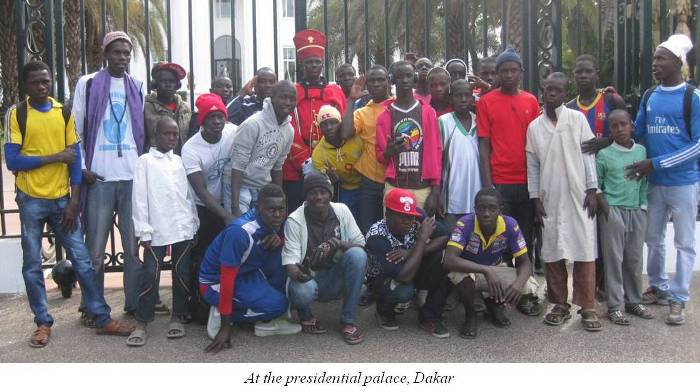News from Maison de la Gare
More Than an Excursion – The Door of No Return
Tweeter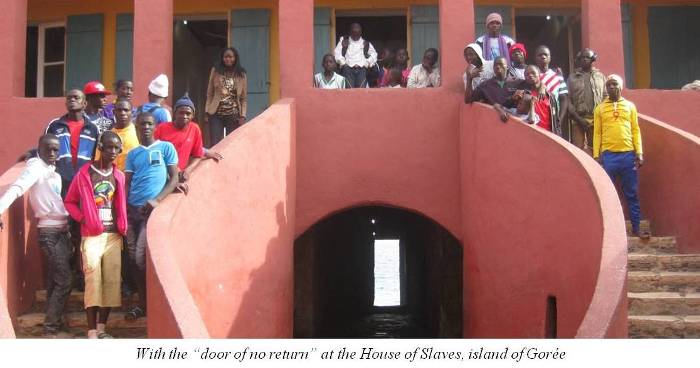
Talibé victims of a contemporary form of slavery visit the island of Gorée
Arouna Kandé, a senior talibé and Maison de la Gare’s
Administrative Assistant, prepared this report of the very moving visit that thirty talibé
children made to the island of Gorée on December 31st, 2014. 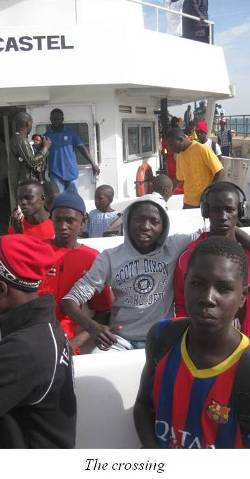 Arouna writes: “The
Portuguese, French, Dutch, Spanish and English controlled the slave trade. Their products
were traded for slaves, provided mostly by African kings. The overloaded boats headed
for the New World, many from Gorée. The crossing of the Atlantic was a terrible ordeal,
lasting four weeks or more. The slaves were chained in the holds crammed like sardines,
branded with a hot iron. Once in the Americas, they were sold at auction. The proceeds
from the sales allowed the Europeans to benefit from the products of the plantation fields:
coffee, tobacco, cotton and sugar cane. This visit taught us how Africa has experienced a
great challenge before independence.”
Arouna writes: “The
Portuguese, French, Dutch, Spanish and English controlled the slave trade. Their products
were traded for slaves, provided mostly by African kings. The overloaded boats headed
for the New World, many from Gorée. The crossing of the Atlantic was a terrible ordeal,
lasting four weeks or more. The slaves were chained in the holds crammed like sardines,
branded with a hot iron. Once in the Americas, they were sold at auction. The proceeds
from the sales allowed the Europeans to benefit from the products of the plantation fields:
coffee, tobacco, cotton and sugar cane. This visit taught us how Africa has experienced a
great challenge before independence.”
Arouna interviewed seven of the talibé
children who participated with him in the visit, and he has recorded their accounts for us
here.
Karfa Kandé, age 13 (Daaras Serigne Thiam) – “When the
marabout  gave me permission to join the other talibé children going to Dakar to visit
Gorée, I was surprised because I never thought that I would go to the capital one day. I
couldn’t sleep on the way. All along the road I watched the houses and woods in the dark.
Arriving in Dakar, my heart started to beat faster because we got on a boat and the sea in
front of us seemed so large
gave me permission to join the other talibé children going to Dakar to visit
Gorée, I was surprised because I never thought that I would go to the capital one day. I
couldn’t sleep on the way. All along the road I watched the houses and woods in the dark.
Arriving in Dakar, my heart started to beat faster because we got on a boat and the sea in
front of us seemed so large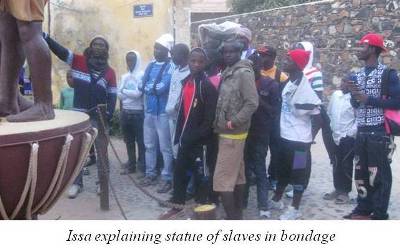 that I was thinking in my head, ‘Where is this going to take
us?’ Arriving on the island of Gorée, there was no one there; it was like a dream. We all
stayed together until people woke up. Later, I understood the purpose of our visit to the
House of Slaves. There were empty rooms, but Issa explained the meaning of these empty
rooms. Why did people want to be sold by the Toubabs (the whites)? How were they sold?”
that I was thinking in my head, ‘Where is this going to take
us?’ Arriving on the island of Gorée, there was no one there; it was like a dream. We all
stayed together until people woke up. Later, I understood the purpose of our visit to the
House of Slaves. There were empty rooms, but Issa explained the meaning of these empty
rooms. Why did people want to be sold by the Toubabs (the whites)? How were they sold?”
Oumar Mballo, age19 (Darra Thierno Harouna Kandé) – “It was on
 December 31, 2014 that we went to visit the island of Gorée. We left Saint Louis at
around 1:30 am and arrived at Gorée at 4 am. After spending the night, we woke up at
7 am to visit the House of Slaves, and we took the boat to cross to it. Once there, we
had breakfast in the company of our friends and the president of our association.
December 31, 2014 that we went to visit the island of Gorée. We left Saint Louis at
around 1:30 am and arrived at Gorée at 4 am. After spending the night, we woke up at
7 am to visit the House of Slaves, and we took the boat to cross to it. Once there, we
had breakfast in the company of our friends and the president of our association.
During our visit, we discovered a lot about the history of Gorée, for example, how
the slaves lived, where they were gathered, and where the boats were moored that
would take them away. We saw monuments that showed the abuse and suffering that
these people were subjected to. We also visited the rooms where the slaves lived
ten to fifteen people per room, with women, men and children being separated. We
learned from the person responsible for the House of Slaves how the slaves were
treated by the whites.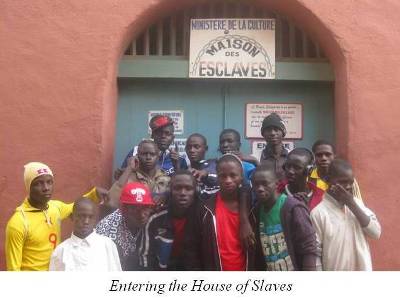 The visit allowed us to learn many things that we did not
know about Gorée as well as about the history of Senegal, in particular of slavery.
The visit allowed us to learn many things that we did not
know about Gorée as well as about the history of Senegal, in particular of slavery.
After this visit, we can say that Gorée is a city full of history like Saint Louis,
but the difference is that when we speak of Saint Louis we allude to the arrival of
whites in this city that became the first capital of Senegal. But Gorée is a city
that reminds us of bad memories, of the suffering and pain experienced by our
society before independence.”
Idrissa Diao, age 15 (Darra Thierno Balde Mansour) – “This was
 the first time I visited Gorée. I saw a lot of things that I have never seen. The
scenery is beautiful, and we discovered a lot about the island of Gorée: monuments,
the rooms of the slaves and the slaves’ door of no return. We were also told about
the conditions in which the slaves lived, ill-treated by the whites. This visit
allowed us to know a lot about the history of the slave trade and especially about
the slaves.”
the first time I visited Gorée. I saw a lot of things that I have never seen. The
scenery is beautiful, and we discovered a lot about the island of Gorée: monuments,
the rooms of the slaves and the slaves’ door of no return. We were also told about
the conditions in which the slaves lived, ill-treated by the whites. This visit
allowed us to know a lot about the history of the slave trade and especially about
the slaves.”
Amadou Sow, age 16 (Daara Thierno Assane Sabaly) – “This
 visit to Gorée was a great highlight in our lives, as it has allowed us to discover
a lot about the history of our country and especially about the human trafficking
of slaves and the precarious conditions under which they lived.
visit to Gorée was a great highlight in our lives, as it has allowed us to discover
a lot about the history of our country and especially about the human trafficking
of slaves and the precarious conditions under which they lived.
Also during this visit, we discovered the monuments that showed us the abuse
suffered by these slaves, and their departure point leaving for Europe and the
United States.”
Ousmane Bâ, age 8 (Daara Serigne Thiam) – “When you hear Dakar,
 it feels like cars are roaring in heaven and there are plenty of planes there too.
The buildings are large, there are police officers in the city, and the roads are
very wide.
it feels like cars are roaring in heaven and there are plenty of planes there too.
The buildings are large, there are police officers in the city, and the roads are
very wide. 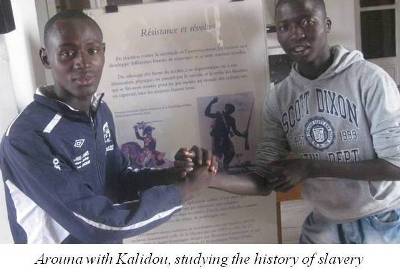 We got into a boat to go to a place like another country. There was
nobody in the houses and no one was speaking. We entered a house where there was
no one, the rooms had no beds, no TV, no toilet. We saw a statue that was speaking
with a sword in its hand. It was like being in a movie.”
We got into a boat to go to a place like another country. There was
nobody in the houses and no one was speaking. We entered a house where there was
no one, the rooms had no beds, no TV, no toilet. We saw a statue that was speaking
with a sword in its hand. It was like being in a movie.”
Ousmane Diagne, age 14 (Darra Serigne Seck) – “At the end of
 December I went to Gorée. We learned so much about the history of Senegal and the
slave trade and the fate of slaves. This trip makes it possible for us to have a
better life. And it was as a part of this adventure that I was able to go to the
palace of the President of the Republic of Senegal.”
December I went to Gorée. We learned so much about the history of Senegal and the
slave trade and the fate of slaves. This trip makes it possible for us to have a
better life. And it was as a part of this adventure that I was able to go to the
palace of the President of the Republic of Senegal.”
Souleymane Ndiaye, age 20 (Daara Thierno Ndiaye) – “It was
 an unforgettable day when I visited Gorée. I've never been there and, thanks to
this visit, I had the opportunity to learn many things. We were shown rooms for
men, women and children slaves. They also showed us some very important things
about the slaves, for example the chains which bound their necks and ankles.
There was a small door called the “door of no return” though which the slaves
departed to go to the Americas. I am really happy to have made this visit,
because it taught me so much about the island of Gorée and the slave trade.”
an unforgettable day when I visited Gorée. I've never been there and, thanks to
this visit, I had the opportunity to learn many things. We were shown rooms for
men, women and children slaves. They also showed us some very important things
about the slaves, for example the chains which bound their necks and ankles.
There was a small door called the “door of no return” though which the slaves
departed to go to the Americas. I am really happy to have made this visit,
because it taught me so much about the island of Gorée and the slave trade.”
